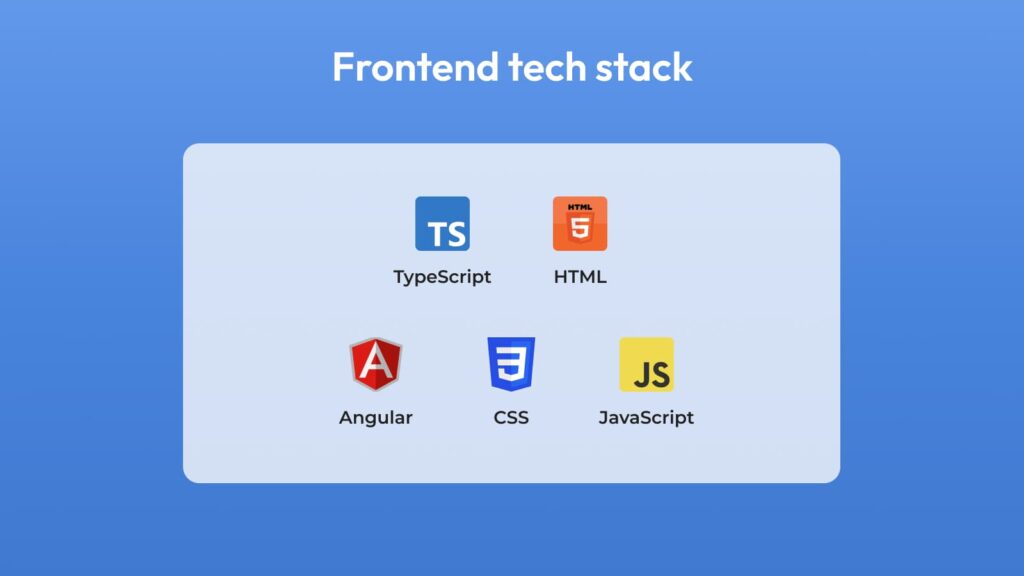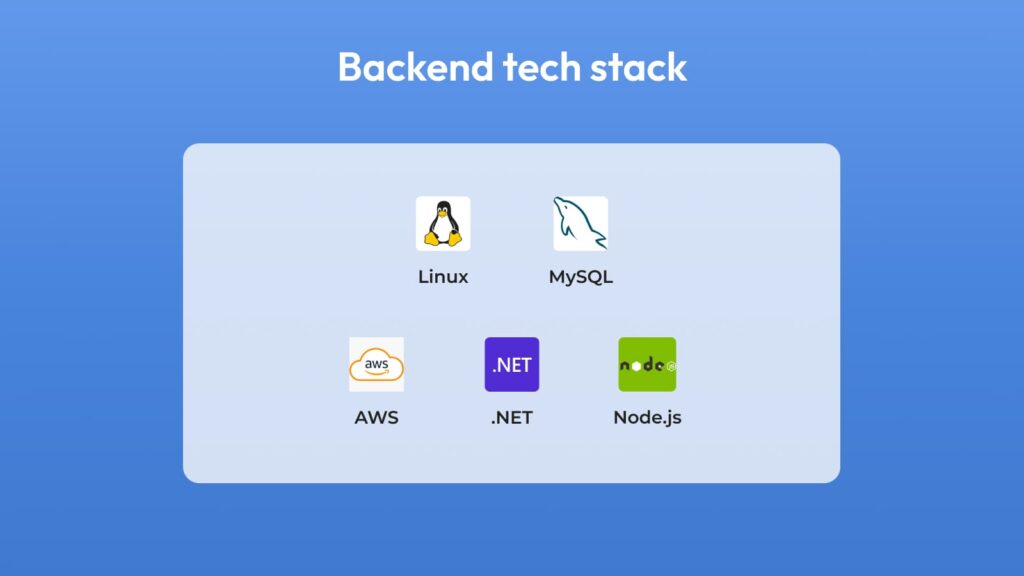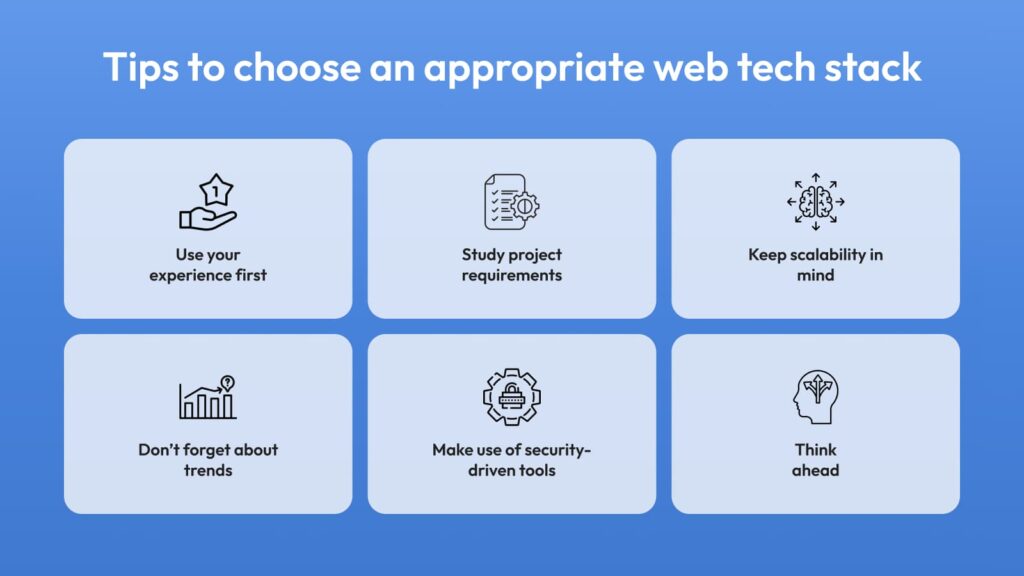Various tools and technologies are used in web development to create dynamic and interactive websites. These toolkits, known as “web development stacks,” combine frontend and backend technologies that work together to build and launch websites.
This article aims to explore popular web development stacks and analyze their advantages and disadvantages. Understanding these stacks can aid in decision-making when selecting technologies for your projects. Let us begin by delving into the topic.
What Is a Web Technology Stack?
A web stack is a combination of software that builds and runs websites and web applications. It includes the operating system (OS), programming languages, database software, and web server. These components work together to create websites and handle client requests.
A web stack is built on multiple components that depend on each other. This creates a smooth process for developers. Using a well-established web stack saves developers time and effort because they use proven technologies that work together effectively. It enables developers to focus on creating unique features and designs instead of starting from scratch each time. In conclusion, a web stack is essential in web development because it provides the necessary tools and systems to build efficient websites and applications.
Frontend technology stack
The frontend technology stack encompasses the tools and frameworks utilized in web development to craft a website or web application’s user interface (UI). It covers all elements visible to users, such as layout, colors, fonts, buttons, forms, and interactive components.
A frontend technology stack typically comprises three main components: HTML, CSS, and JavaScript. Let’s delve deeper into each of these vital components:
1. HTML (HyperText Markup Language): HTML is the foundational markup language for constructing web page structure and content. It delineates various elements’ arrangement and hierarchy, including headings, paragraphs, images, links, and lists.
2. CSS (Cascading Style Sheets): CSS is pivotal in dictating the visual presentation and layout of the web page. It dictates the styles, colors, fonts, and positioning of HTML elements, ensuring cohesive and visually appealing designs across the site.
3. JavaScript: JavaScript serves as a versatile programming language, enriching web pages with interactivity and responsiveness. It enables developers to incorporate functionalities like form validation, animations, and adaptive layouts. Utilizing JavaScript frameworks such as React.js and Angular.js enhances functionality and accelerates development workflows.

Backend technology stack
The backend technology stack encompasses the tools and frameworks utilized for server-side development, focusing on managing data, processing requests, and implementing the application’s business logic. This stack typically includes:
1. Programming languages: Backend development commonly employs Python, Ruby, PHP, Java, and Node.js.
2. Web frameworks: Frameworks such as Ruby on Rails, Django, Laravel, Spring Boot, and Express.js offer structured approaches to backend application development, providing pre-built components and libraries.
3. Databases: Backend systems often interact with databases for data storage and retrieval. Options include relational databases like MySQL and PostgreSQL and NoSQL databases like MongoDB and Cassandra.
4. Web servers: Responsible for handling client-server communication; web servers like Apache, Nginx, and Microsoft IIS process incoming requests and deliver responses.
5. APIs (Application Programming Interfaces) facilitate communication between software systems, allowing frontend and backend components to exchange data and perform tasks. RESTful APIs are widely used for this purpose.

Web Technology Stack Picking: Determining Factors
When choosing a web technology stack, there are various factors to consider.
1. Project Requirements: Start by assessing the requirements of your project. Consider the complexity of the website or application you need to build and any specific functionalities or features it requires. Some technology stacks may be better suited for specific projects, so understanding your requirements will help narrow your options.
2. Scalability is an essential factor to consider if your website or application is expected to handle a large volume of traffic or data in the future. Choose a technology stack that can quickly scale to meet growing demands without compromising performance.
3. Developer Skillset: Consider the skills and expertise of your development team. If someone has experience and knowledge in a specific language or framework, it may be more efficient to choose a stack that aligns with their skillset. This will allow them to work more comfortably and effectively, minimizing learning curves and potential errors.
4. Community Support: Look into the size and activity level of the community surrounding a particular technology stack. A vibrant and active community means that there will be ample resources, documentation, tutorials, and support available if you run into any issues during development.
5. Assess the performance capabilities of various technology stacks. Consider factors such as speed, efficiency, and memory usage to ensure optimal performance for your website or application.
6. Security is an essential factor when selecting a web technology stack. Look for stacks that have robust security measures built-in or provide easy integration with security tools and protocols.
7. Consider the cost of your development budget and the ongoing maintenance and support expenses related to different stacks. Some technologies may require additional licenses or subscriptions, so consider these costs.
8. It is important to consider the longevity and relevance of your chosen technology stack to future-proof your system. Look for regularly updated stacks with a strong roadmap for future development to make sure that your website or application will remain supported and compatible with evolving technologies.
Valuable Tips to Select a Web Technology Stack for Your Project
It is advisable to follow these tips to select the optimal technology stack for web development.

Prioritizing your experience is essential.
You should utilize the experience and skills of your team. For example, if you have Node.js developers and JavaScript specialists, use them to build a web application. Learning something new is still necessary, but using your existing skills is better. Additionally, if it’s a typical web app, you likely have tools that can be integrated quickly, making it easier to build a website or web app.
List your project requirements.
First, determine your target audience and build the project for them. Consider their age and interests to meet their expectations. Next, define the project’s complexity – a simple landing page or an eCommerce website. Based on this, select the appropriate web application stack. Angular is ideal for single-page web apps, while complex websites may require JS frameworks, databases, and storage.
Stay scalable.
Your web app’s architecture should be simple yet scalable. Keep in mind the possibility of adding features in the future. Scalability ensures your app can handle increased load and unexpected user numbers. Choose between horizontal or vertical scalability based on your needs. To achieve scalability, use powerful programming languages with libraries and frameworks that enhance flexibility, like JavaScript.
Follow the trends.
Use tried and tested tools for web app development. Make sure these technologies will remain popular in the future. Using widely accepted tools is reliable and gives you access to solutions from the online community. Stay current with trends, but consider the future.
Focus on security.
Use encrypted and protected technologies for your financial software development and data processing to ensure customer satisfaction and security. Learn about security issues before integrating any tools to provide a reliable service.
Assess your skills.
Choose a technology that enables you to successfully implement all your software development needs without facing challenges or budget issues. Take on only what you can handle.
Consider efficiency.
Stick with what works for your web development team. Even though new technology may be popular now, it might be unreliable in the long run. Instead, choose well-tested and trusted tech stacks like MEAN and .Net.
Summarizing
In conclusion, selecting the most suitable web technology stack for a web application can be daunting. However, adhering to recommended practices and utilizing established technologies can increase their chances of success.